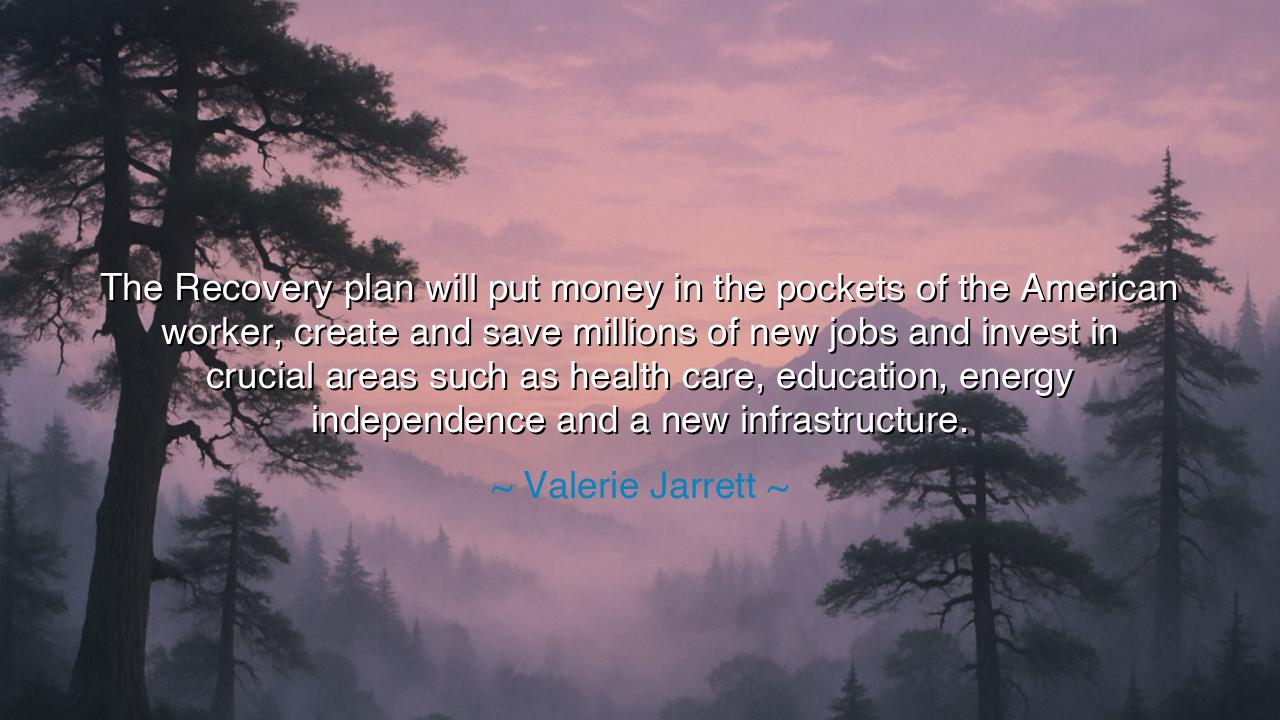
The Recovery plan will put money in the pockets of the American
The Recovery plan will put money in the pockets of the American worker, create and save millions of new jobs and invest in crucial areas such as health care, education, energy independence and a new infrastructure.






When Valerie Jarrett spoke the words, “The Recovery plan will put money in the pockets of the American worker, create and save millions of new jobs and invest in crucial areas such as health care, education, energy independence and a new infrastructure,” she was speaking not merely of policy, but of rebirth — the deliberate act of lifting a wounded nation from despair toward renewal. Her voice echoed across a time of fear and uncertainty — the years following the Great Recession, when factories had fallen silent, homes lay abandoned, and millions stood on the edge of ruin. Her declaration was not simply economic; it was spiritual, a promise that the nation would not remain bowed under the weight of crisis, but rise again through unity, labor, and faith in one another.
In those dark days, America faced a reckoning. The collapse of markets had exposed the fragility of systems built upon greed, and the people cried out not for charity, but for dignity through work. The Recovery Plan — known formally as the American Recovery and Reinvestment Act of 2009 — sought to heal that wound. It aimed to restore not only the flow of money but the circulation of hope, by rebuilding the nation’s foundations: health, knowledge, energy, and roads — the arteries of progress. Jarrett, one of President Obama’s most trusted advisors, spoke as both a witness and a believer, affirming that a society’s greatness lies not in its wealth, but in how it restores strength to the common man.
The ancient philosophers would have understood this. For what is a “recovery plan” if not a modern echo of the old concept of renewal after calamity? After every fall of empire or city — from Athens to Rome, from Jerusalem to Carthage — came the same question: How shall we rebuild, and what shall we value? In those moments, leaders either turned inward toward greed or outward toward justice. Jarrett’s words carry the wisdom of the latter path: that the prosperity of a nation is not secured by the few, but by the empowerment of the many. To put “money in the pockets of the worker” is to restore the pulse of a civilization; to invest in education and health is to invest in its soul.
Consider the story of Franklin D. Roosevelt during the Great Depression — another time when America trembled. His New Deal programs put men back to work building bridges, planting forests, and paving roads. But the true genius of his plan was not the labor itself; it was the faith that labor rekindled. Men who had felt forgotten stood once more beneath the open sky, their hands shaping the future of a nation. So too did Jarrett’s vision call back to that sacred principle: that work restores dignity, and that public investment, when guided by wisdom, can turn despair into determination.
When Jarrett spoke of energy independence, she was not merely referring to fuel or power. She spoke of the deeper independence — the kind that comes when a people no longer rely upon others for their survival. A nation that feeds, educates, heals, and energizes its own stands truly free. Thus, the Recovery Plan was more than an act of economic policy; it was a manifesto of resilience, a vow that America would not only recover from crisis but redefine what strength means in the modern age.
Yet, as with all great visions, its power depends on the people’s participation. No law, no government, can save a people who do not lift themselves with it. The ancients taught that the hands of the builder are as sacred as the mind of the philosopher. So it is in our time: every worker who rebuilds a road, every teacher who inspires a child, every nurse who heals a wound becomes part of the nation’s recovery. Jarrett’s quote reminds us that progress is a covenant — between leadership and the led, between vision and action, between word and deed.
So, my children of the modern age, take this teaching to heart: when the world falters, do not despair. Look not to the ruins, but to the raw earth from which you may build anew. Remember that recovery, whether of a nation or of a soul, is not achieved by waiting, but by working with purpose and compassion. As Valerie Jarrett foresaw, the greatness of a people lies in their ability to rise after the fall — not by turning against one another, but by joining hands to build something greater than before. For in the labor of renewal, every citizen becomes both the architect and the guardian of tomorrow.






AAdministratorAdministrator
Welcome, honored guests. Please leave a comment, we will respond soon